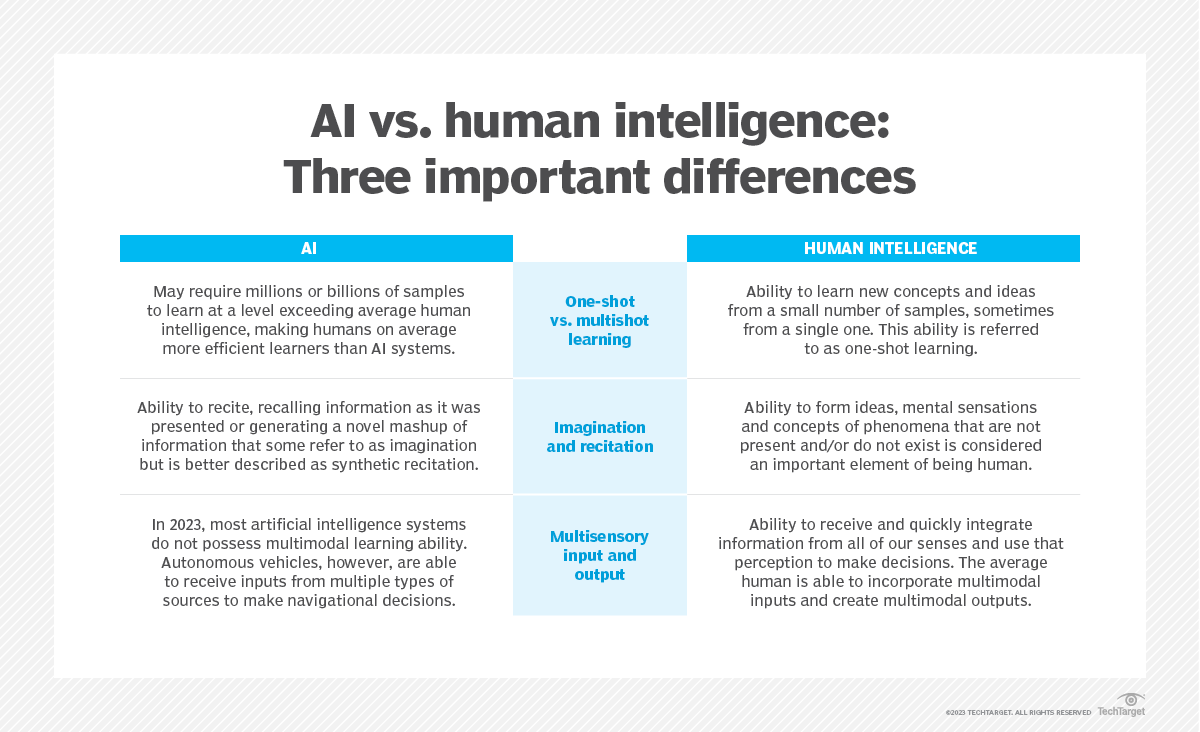The 7 Types of AI - And Why We Talk (Mostly) About 3 of Them
What are the 7 types of artificial intelligence?
Narrow AI or artificial narrow intelligence (ANI)
General AI or artificial general intelligence (AGI)
Super AI or artificial superintelligence (ASI)
Reactive machines.
Limited memory.
Theory of mind.
Self-aware.
10 types of AI and how to use them
https://www.walkme.com/blog/types-of-ai/Here are some types of artificial intelligence (AI):
Reactive machines
A basic form of AI that responds to predefined scenarios without learning or making decisions. They are reliable and efficient for applications that require repetitive operations. Examples include IBM's Deep Blue and Google's AlphaGo.
Limited memory
AI models that can learn from past data and improve their performance over time. They can analyze data inputs and make predictions based on patterns observed in the past.
Artificial narrow intelligence (ANI)
AI systems that perform tasks autonomously with human-like capabilities.
Artificial general intelligence (AGI)
AI that is designed to think, reason, and act like a human. It can learn, reason, and make decisions in a wide variety of contexts.
Artificial superintelligence (ASI)
A concept of an AI that vastly outperforms human intelligence in almost all applicable fields.
Self-aware
The final stage of AI development, where machines will be able to deeply understand and be aware of complex human emotions and mental states.
Generative AI is experimental.
What are the main 7 areas of AI?
Computer vision.
Fuzzy logic.
Expert systems.
Robotics.
Machine learning.
Neural networks/deep learning.
Natural language processing.
What are the 6 laws of AI?
The six key principles for responsible AI at Microsoft include fairness, reliability and safety, privacy and security, inclusiveness, transparency, and accountability.
What are the 6 domains of AI?
The domains of AI, including Machine Learning, Deep Learning, Natural Language Processing, Computer Vision, and Data Science, are at the forefront of this technological revolution.
What is the golden rule of AI?
AI's golden rule: Good data inputs equal better AI outputs. To address consumers' needs and desires, data must be high quality and gathered in real time.
Can AI rule over humans?
Many scholars, including evolutionary psychologist Steven Pinker, argue that a superintelligent machine is likely to coexist peacefully with humans. The fear of cybernetic revolt is often based on interpretations of humanity's history, which is rife with incidents of enslavement and genocide.
Who is the father of AI?
John McCarthy
The correct answer is option 3 i.e John McCarthy. John McCarthy is considered as the father of Artificial Intelligence. John McCarthy was an American computer scientist. The term "artificial intelligence" was coined by him.
What are the 3 laws for AI?
A robot may not injure a human being or, through inaction, allow a human being to come to harm. A robot must obey orders given it by human beings except where such orders would conflict with the First Law. A robot must protect its own existence as long as such protection does not conflict with the First or Second Law.
What is the primary goal of AI?
One of the primary goals of AI is to augment human capabilities, not just replace human efforts. AI systems are designed to enhance human decision-making and productivity, providing support in complex data analysis, prediction, and mechanical tasks.
What will be obsolete in 2030?
Hit and declining occupations
Data entry and data processing. For years, data entry and data processing tasks have been fundamental to the technology sector. ...
Manual software testing. ...
Routine customer support roles. ...
Telemarketing roles. ...
Fast food workers. ...
Administrative legal positions. ...
Outbound sales people. ...
Drivers.
What is the most powerful AI technology?
The Top Ten Artificial Intelligence Technologies
Decision management. ...
Deep learning platforms. ...
Machine learning. ...
Natural language processing (NLP) and text analytics. ...
Peer-to-peer network. ...
Robotic process automation. ...
Speech recognition. ...
Virtual agents. Virtual agents are computer applications that interact with people.
Who invented AI?
Alan Turing
Birth of AI: 1950-1956
Alan Turing published his work “Computer Machinery and Intelligence” which eventually became The Turing Test, which experts used to measure computer intelligence. The term “artificial intelligence” was coined and came into popular use.
What is the ultimate purpose of AI?
Artificial Intelligence (AI) works by simulating human intelligence through the use of algorithms, data, and computational power. The goal is to enable machines or software to perform tasks that typically require human intelligence, such as learning, reasoning, problem-solving, perception, and language understanding.
Are we already in the singularity?
While the technological singularity is usually seen as a sudden event, some scholars argue the current speed of change already fits this description. In addition, some argue that we are already in the midst of a major evolutionary transition that merges technology, biology, and society.


 Total Posts: 12612
Total Posts: 12612 Total Topics: 5007
Total Topics: 5007 Online Today: 216
Online Today: 216 Online Ever: 816
Online Ever: 816 Total Posts: 12612
Total Posts: 12612 Total Topics: 5007
Total Topics: 5007 Online Today: 216
Online Today: 216 Online Ever: 816
Online Ever: 816